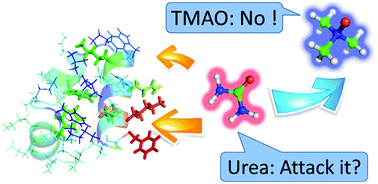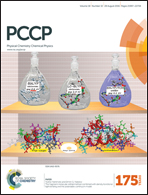Microscopic significance of hydrophobic residues in the protein-stabilizing effect of trimethylamine N-oxide (TMAO)†
Abstract
Although it is widely known that trimethylamine N-oxide (TMAO) stabilizes the native structure of proteins, the underlying mechanism of its action is poorly documented. To obtain an in-depth understanding of this important osmolyte molecule, we conducted large-scale molecular dynamic simulations of model proteins, namely, wild-type villin headpiece protein HP35 and its doubly norleucine-substituent mutant (Lys24/29Nle) HP35NN in pure urea and urea + TMAO mixed solutions for direct comparison. From extensive sampling, the protective capability of TMAO was well captured in the simulations, where HP35NN demonstrated a significantly more stable native structure than HP35 in the presence of TMAO, whereas in pure urea solution, the former denatured in a shorter time. These findings highlight the importance of the two norleucine residues that regulates the interactions of proteins with urea and TMAO. By accessing the hydration and conformational dynamics of both proteins, we were able to directly probe how TMAO compensates the denaturing effect of urea at the atomic level. The accumulation of urea around hydrophobic residues is clearly suppressed, which indicates that the van der Waals interactions between urea and proteins are weakened by TMAO. As a consequence, the hydrophobic core of protein is preferentially protected by TMAO against urea attack. Although the hydrogen bonds (H-bonds) between proteins and urea are suppressed by TMAO, this plays a very minor role than expected in the enhanced protein stability. In addition, TMAO was found to be always excluded from the protein surface and incapable of forming H-bonds with proteins. Thus, the present study provides solid evidence to support the indirect mechanism of TMAO counteracting the denaturing effects of urea.


 Please wait while we load your content...
Please wait while we load your content...